Overview
The purpose of this lesson is to help students understand government policy in relation to Native American Tribes from approximately 1870-1900 in American History through analysis of primary sources that include a portion of the Dawes Act of 1887, various photographs of Indian Boarding Schools and their students, and a report from an Indian Boarding School Superintendent. Depending on class schedule, this lesson may take 1+ days to complete.
Background
Information
This lesson can be included as part the study of American History during the latter half the 19th century. It may be beneficial for students to have some knowledge of Native American History from European exploration in the Americas to contemporary tribal land organization, government treaties, and the reservation system.
Objectives
1. Students will collaborate with peers to analyze primary documents related to Native American relations with the U.S. government.
2. Students will complete a comparative chart of chosen primary documents.
3. Students will reflect on the effects of government policy toward American Indians of various tribes from approximately 1870-1900 by responding to a freewrite prompt.
Teacher Materials Student
Materials
Copy of each primary source included below (8) Pencil/pen
Copies of Student Primary Source Analysis Worksheets
Copies of Freewrite Reflection Sheets
LESSON PROCEDURE / SCHEDULE OF ACTIVITIES
1. Introduction / Opening Discussion
Introduce the topic of U.S. Government and Native American tribal relations during this time period. Ask students what they know about the way the government and Native American peoples had interacted before this time period.
2. Discussion of Primary Sources in Small Groups
Divide students into small groups based on class size or number of primary sources included in this lesson. There are 8 sources included. Pass out one or more (depending on number of groups) sources to each group of students. Instruct students to look at the photograph or read the transcript or report, depending on which source they received. Students should discuss with their group the answers to the 5 “W” Questions: Who is involved? What are the effects of what is going on in this source? Where is this taking place? When is this taking place? Why is this situation occurring? After discussing the source with their group, instruct them to complete their Primary Source Analysis Sheet for that particular document.
After 5-10 minutes with each primary source, instruct students to pass sources to the next group until all groups have looked at each source.
3. Individual Completion of Freewrite Reflection
When all groups have had an opportunity to look at each source and discuss it, if time allows you may want to discuss findings as a large-group. Otherwise, pass out the Freewrite Reflection prompt questions and instruct students to respond to the prompts to the best of their ability.
4. Closure
You may choose to finish the lesson with a large-group discussion or reading of Freewrite Reflections.
Assessment
For this lesson, students may be assessed according to the participation in small groups as well as their contributions to classroom discussion. Additionally, students will individually complete a comparative Primary Source Analysis sheet and Freewrite Refection on the lesson’s activities that can be used as an assessment tool to gauge understanding.
Additional
Information
For further information and resources, visit the sites listed below under primary sources. If you would like to include it, www.ourdocuments.gov has a short summary of the Dawes Act that may act as a nice introductory or closure piece for this lesson.
Native American Relations (1870-1900): Primary Source
1
Online Source: http://www.ourdocuments.gov/doc.php?doc=50#
*Sections 5-11 of document are available online as well as high resolution images.
Transcript of Dawes Act (1887) |
Forty-Ninth Congress of the United States of
America;
At the Second Session,
Begun and held at the City of Washington on Monday, the sixth day of December, one thousand eight hundred and eight-six.
An Act to provide for the allotment of lands in severalty to Indians on the various reservations, and to extend the protection of the laws of the United States and the Territories over the Indians, and for other purposes.
Be it enacted by the Senate and House of Representatives of the United States of America in Congress assembled, That in all cases where any tribe or band of Indians has been, or shall hereafter be, located upon any reservation created for their use, either by treaty stipulation or by virtue of an act of Congress or executive order setting apart the same for their use, the President of the United States be, and he hereby is, authorized, whenever in his opinion any reservation or any part thereof of such Indians is advantageous for agricultural and grazing purposes, to cause said reservation, or any part thereof, to be surveyed, or resurveyed if necessary, and to allot the lands in said reservation in severalty to any Indian located thereon in quantities as follows:
To
each head of a family, one-quarter of a section;
To each single person over eighteen years of age, one-eighth of a section;
To each orphan child under eighteen years of age, one-eighth of a section; and
To each other single person under eighteen years now living, or who may be born
prior to the date of the order of the President directing an allotment of the
lands embraced in any reservation, one-sixteenth of a section:
Provided, That in case there is not sufficient land in any of said reservations to allot lands to each individual of the classes above named in quantities as above provided, the lands embraced in such reservation or reservations shall be allotted to each individual of each of said classes pro rata in accordance with the provisions of this act: And provided further, That where the treaty or act of Congress setting apart such reservation provides the allotment of lands in severalty in quantities in excess of those herein provided, the President, in making allotments upon such reservation, shall allot the lands to each individual Indian belonging thereon in quantity as specified in such treaty or act: And provided further, That when the lands allotted are only valuable for grazing purposes, an additional allotment of such grazng lands, in quantities as above provided, shall be made to each individual.
Sec. 2. That all allotments set apart under the provisions of this act shall be selected by the Indians, heads of families selecting for their minor children, and the agents shall select for each orphan child, and in such manner as to embrace the improvements of the Indians making the selection. where the improvements of two or more Indians have been made on the same legal subdivision of land, unless they shall otherwise agree, a provisional line may be run dividing said lands between them, and the amount to which each is entitled shall be equalized in the assignment of the remainder of the land to which they are entitled under his act: Provided, That if any one entitled to an allotment shall fail to make a selection vithin four years after the President shall lirect that allotments may be made on a particular reservation, the Secretary of the Interior may direct the agent of such tribe or band, if such there be, and if there be no agent, then a special agent appointed for that purpose, to make a selection for such Indian, which selection shall be allotted as in cases where selections are made by the Indians, and patents shall issue in like manner.
Sec. 3. That the allotments provided for in this act shall be made by special agents appointed by the President for such purpose, and the agents in charge of the respective reservations on which the allotments are directed to be made, under such rules and regulations as the Secretary of the Interior may from time to time prescribe, and shall be certified by such agents to the Commissioner of Indian Affairs, in duplicate, one copy to be retained in the Indian Office and the other to be transmitted to the Secretary of the Interior for his action, and to be deposited in the General Land Office.
Sec. 4. That where any Indian not residing upon a reservation, or for whose tribe no reservation has been provided by treaty, act of Congress, or executive order, shall make settlement upon any surveyed or unsurveyed lands of the United States not otherwise appropriated, he or she shall be entitled, upon application to the local land-office for the district in which the lands arc located, to have the same allotted to him or her, and to his or her children, in quantities and manner as provided in this act for Indians residing upon reservations; and when such settlement is made upon unsurveyed lands, the grant to such Indians shall be adjusted upon the survey of the lands so as to conform thereto; and patents shall be issued to them for such lands in the manner and with the restrictions as herein provided. And the fees to which the officers of such local land-office would have been entitled had such lands been entered under the general laws for the disposition of the public lands shall be paid to them, from any moneys in the Treasury of the United States not otherwise appropriated, upon a statement of an account in their behalf for such fees by the Commissioner of the General Land Office, and a certification of such account to the Secretary of the Treasury by the Secretary of the Interior.
Approved, February, 8, 1887.
Native American Relations (1870-1900): Primary Source
2
Online Source: http://www.hanksville.org/sand/intellect/gof.html
Website Description: Sioux boys as they were dressed on arrival at the Carlisle Indian School, Pennsylvania. (NWDNS-75-IP-1-4A)
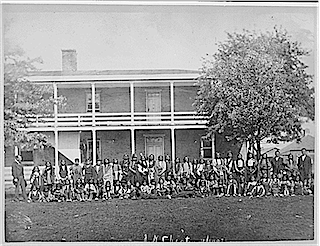
Still Pictures Branch (NWDNS), National Archives at College Park, 8601 Adelphi Road, College Park, MD
Native American Relations (1870-1900): Primary Source
3
Online Source: http://www.hanksville.org/sand/intellect/gof.html
Website Description: Young school girls attending sewing class at Albuquerque Indian School. (NRG-75-AISP-14)
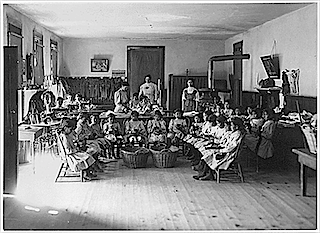
NARA's Rocky Mountain Region (Denver, CO) (NRG), Denver Federal Center, Building 48, P.O. Box 25307, Denver, CO
Native American Relations (1870-1900): Primary Source
4
Online Source: http://www.hanksville.org/sand/intellect/gof.html
Website Description: Very early class of young boys with flags at the Albuquerque Indian School. (NRG-75-AISP-10)
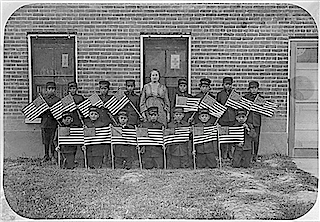
NARA's Rocky Mountain Region (Denver, CO) (NRG), Denver Federal Center, Building 48, P.O. Box 25307, Denver, CO
Native American Relations (1870-1900): Primary Source
5
Online Source: http://www.hanksville.org/sand/intellect/gof.html
Website Description: A class room at the Carlisle Indian School. The school has 14 classrooms representing instruction in the elements of knowledge such as reading, writing, arithmetic, geography, spelling, history, nature study, the use of good English, etc. A thorough training is given in arithmetic, but no instruction is given in the higher mathematics or in foreign languages. (NRIS-75-PAOLAVATTA-CARL39)
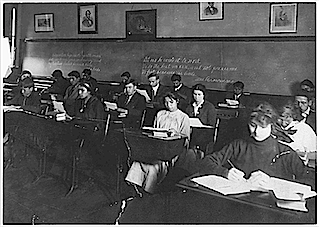
NARA's Pacific Alaska Region (Seattle, WA) (NRIS), 6125 Sand Point Way NE, Seattle, WA
Native American Relations (1870-1900): Primary Source
6
Online Source: http://www.hanksville.org/sand/intellect/gof.html
Website Description: Group of Omaha boys in cadet uniforms, Carlisle Indian School, Pennsylvania. (NWDNS-75-IP-1-10)
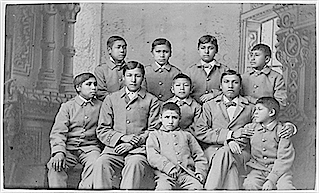
Still Pictures Branch (NWDNS), National Archives at College Park, 8601 Adelphi Road, College Park, MD
Native American Relations (1870-1900): Primary Source
7
Online Source: http://content.lib.washington.edu/cdm4/item_viewer.php?CISOROOT=/loc&CISOPTR=59&CISOBOX=1&REC=12
Website Description: Industrial Boarding School buildings on the Puyallup Reservation, ca. 1885. This photo shows the buildings and students of the Industrial Boarding School on the Puyallup Reservation, Washington Territory, sometime between 1880 and 1889. During the 1880s, a number of new buildings were added, and the school grew from 125 to about 200 pupils. Later called the Cushman School, it remained open until 1920. By that time, Indian children were allowed to attend local public schools.
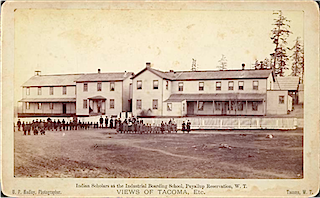
Native American Relations (1870-1900): Primary Source
8
Online Source: http://content.lib.washington.edu/
Website Description:
Title: Report of Harrison Institute, Chemawa, Oregon, Author: Irwin, G. M. Publisher: United States. Office of the
Commissioner of Indian Affairs.
Date of Publication 1891. Notes: Chemawa, Marion County, Oregon, August
20, 1891 Report to Commissioner of Indian Affairs
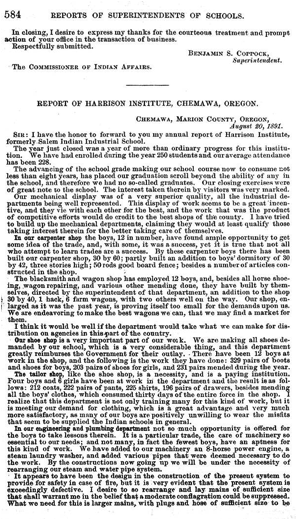
Name: ________________________
Date: _________________________
Primary Source Analysis: Native Americans & U.S. Government Policy
1870-1900
Instructions: For each primary source, answer the questions at the top of the graphic organizer. Make sure to give each primary source a title of your choosing in column 1.
|
|
What type of
primary source is this? (Ex.
Letter, Photograph, Speech, Interview, etc.) |
When was this
primary source produced? Who is involved in this primary source? |
How is this primary
source different from the last you looked at / read? |
|
Primary Source 1: |
|
|
|
|
Primary Source 2: |
|
|
|
|
Primary Source 3: |
|
|
|
|
Primary Source 4: |
|
|
|
|
Primary Source 5: |
|
|
|
|
|
What type of
primary source is this? (Ex.
Letter, Photograph, Speech, Interview, etc.) |
When was this
primary source produced? Who is involved in this primary source? |
How is this primary
source different from the last you looked at / read? |
|
Primary Source 6: |
|
|
|
|
Primary Source 7: |
|
|
|
|
Primary Source 8: |
|
|
|
Name: ________________________
Date: _________________________
Freewrite Reflection: Native Americans & U.S. Government Policy
1870-1900
Instructions: After looking at each of the primary sources included in today’s lesson, respond to the following questions in the form of a freely written essay below. Make sure to answer each of the prompt questions.
Freewrite Prompt(s): What “messages” do you think are included in the primary sources you looked at? Be specific. Do you think there are “messages” that are repeated in more than one of the sources? Based on the sources you looked at and/or read, how would you describe U.S. government policy toward Native American peoples during this time period? What kind of stance did the government take toward Native American relations? Do you think this was beneficial or detrimental for Native American peoples? Why?